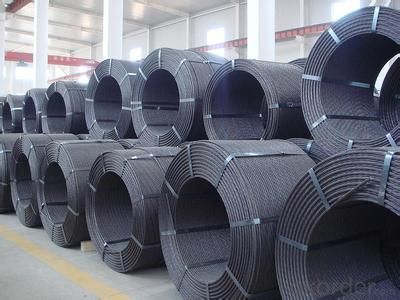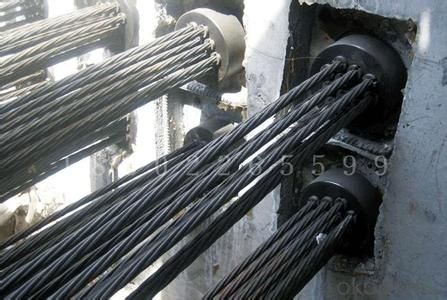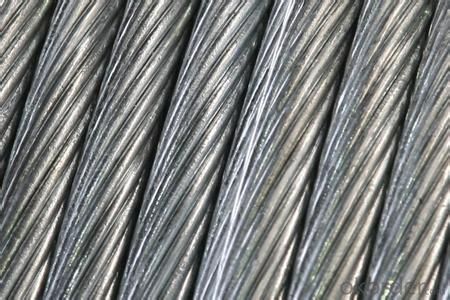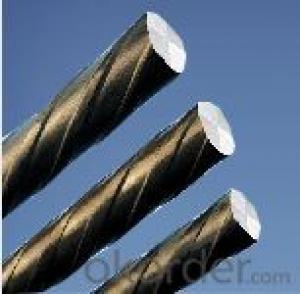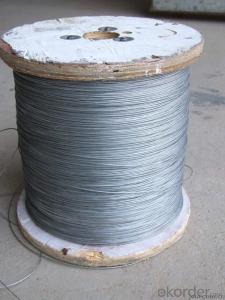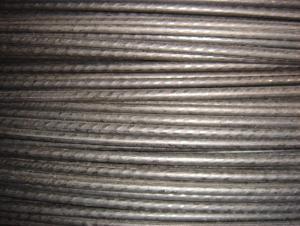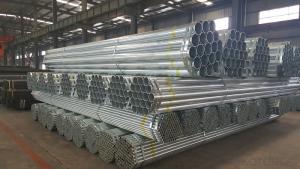High Tensile Steel Wire with Spiral Ribs
- Loading Port:
- China main port
- Payment Terms:
- TT or LC
- Min Order Qty:
- 20 m.t.
- Supply Capability:
- 3000 m.t./month
OKorder Service Pledge
OKorder Financial Service
You Might Also Like
1、Structure of High Tensile PC Steel Wire with Spiral Ribs Description:
Prestressed Concrete Steel Wire, also named PC steel wire orPC wire, is made from high carbon steel with low relaxation high tensile strength. PC wires are sorted into plain surface PC wire, spiral ribs PC wire and indented PC wire. They are commonly used for concrete structure reinforcement such as highway, high-speed railway projects, large-span bridges, overhead crane beam, coal mines.
2、Main Features of High Tensile PC Steel Wire with Spiral Ribs:
•Perfect cohesion. Spiral ribs and indented surface can strengthen the bond between wire and concrete, thus it improves the performance of the PC products and extends its life.
•Low relaxation high tensile strength. With low relaxation 2.5% and tensile strength up to 1860Mpa.
3、High Tensile PC Steel Wire with Spiral Ribs Images:
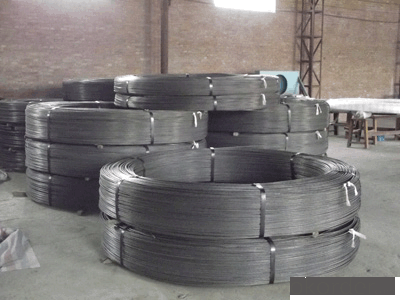
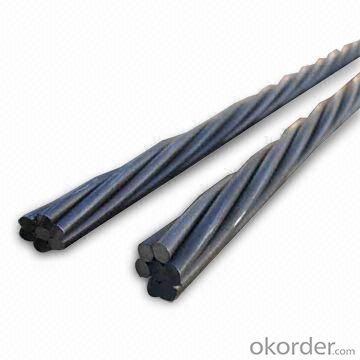
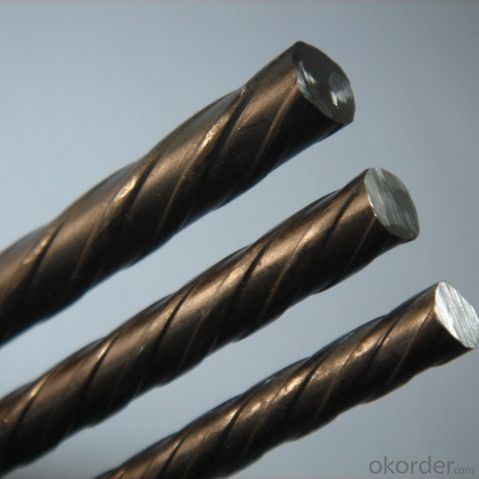
4、High Tensile PC Steel Wire with Spiral Ribs Specification:
Quick Details
Steel Grade: 77B or 82B high carbon wire rod
Standard: GB
Wire Gauge: 4.0mm to 10.0mm
Place of Origin: Tianjin, China (Mainland)
Type: PC
Application: Construction
Model Number: 4.0mm to 10.0mm
Packaging & Delivery
| Packaging Details: | Each coil is strapped by steel bands and fully wrapped in anti-rust paper & P.P woven sheet. |
|---|---|
| Delivery Detail: | within three week after confirm the order or contract. |
The character of the spiral ribs wire is there are 3-6 protruding ribs on the surface.
The new product was invented by Silvery Dragon in 1991, and the research program of the product includes spiral drawing die, spiral deforming technique etc. 12 proprietary technologies. The product is characteristic of 3 to 6 spiral ribs through spiral deforming drawing on the surface of wire, increasing the bond ability with concrete and raising PC products properties. Since 1997, spiral rib PC wire has already fully took place of indented PC wire, and it has been applied in PC telegraph pole, PC hollow floor plate, PC sleeper, high-speed railway PC sleeper plate, PC water supply pipe etc. Since 1996, it has already been exported to the overseas market. In 2006, the product passed the examination and certificate on the properties by German TU Munich; now the product is applied by Great Britain, Ireland, Bangladesh, German, Poland, etc. more than 30 countries. The production of the product is according to Chinese GB/T5223-2002. Except the shape, other standards for mechanical properties are interchangeable with those popular in the world, or we can use the reasonable standard after consulting with customers.
5、FAQ of High Tensile PC Steel Wire with Spiral Ribs:
①How is the quality of your products?
Our products are manufactured strictly according to national and internaional standard, and we take a test on every pipe before delivered out. If you want see our quality certifications and all kinds of testing report, please just ask us for it.
Guaranteed: If products’ quality don’t accord to discription as we give or the promise before you place order, we promise 100% refund.
②How about price?
Yes, we are factory and be able to give you lowest price below market one, and we have a policy that “ for saving time and absolutely honest business attitude, we quote as lowest as possible for any customer, and discount can be given according to quantity”,if you like bargain and factory price is not low enough as you think, just don’t waste your time.Please trust the quotation we would give you, it is professional one.
③Why should you chose us?
Chose happens because of quality, then price, We can give you both.Additionally, we can also offer professional products inquiry, products knowledge train(for agents), smooth goods delivery, exellent customer solution proposals.Our service formula: good quality+good price+good service=customer’s trust
SGS test is available, customer inspection before shipping is welcome, third party inspection is no problem.
Any question, pls feel free to contact us !
- Q: How are steel pipes tested for quality?
- Steel pipes are tested for quality through various methods such as visual inspection, dimensional measurement, mechanical testing, and non-destructive testing. Visual inspection ensures that there are no surface defects or deformities on the pipes. Dimensional measurement involves checking the pipe's size, thickness, and length to meet the required specifications. Mechanical testing involves subjecting the pipes to stress, pressure, and temperature to assess their strength and durability. Non-destructive testing techniques like ultrasonic, radiographic, or magnetic particle testing are used to detect any internal flaws or defects without damaging the pipes. These comprehensive quality tests ensure that steel pipes meet the necessary standards before they are used in various applications.
- Q: Can steel pipes be used for underground telecommunications networks?
- Yes, steel pipes can be used for underground telecommunications networks. Steel pipes are commonly used for their durability, strength, and resistance to corrosion, making them suitable for protecting and housing telecommunication cables underground. They provide reliable protection against external elements and mechanical damage, ensuring the smooth operation of underground telecommunications networks.
- Q: What are the factors to consider when designing a steel pipe system?
- When designing a steel pipe system, several factors need to be considered. Firstly, the intended purpose of the system and the materials that will be transported through it are crucial. This determines the required pipe diameter, thickness, and material type to ensure compatibility and prevent corrosion or leakage. Secondly, the operating conditions, such as temperature, pressure, and flow rate, must be examined to select pipes with suitable strength and resistance properties. Additionally, factors like environmental conditions, including soil characteristics and exposure to chemicals or natural elements, should be evaluated to determine the necessary protective coatings or insulation. Lastly, considerations like installation requirements, regulatory compliance, and maintenance accessibility should be taken into account to design a practical and efficient steel pipe system.
- Q: What is the difference between internal and external coating of steel pipes?
- The main difference between internal and external coating of steel pipes is their purpose and the materials used. The internal coating is applied to the inside surface of the pipe to protect it from corrosion, erosion, and chemical reactions with the transported fluids. It is typically made of materials such as epoxy or polyethylene. On the other hand, the external coating is applied to the outside surface of the pipe to provide protection against atmospheric corrosion, soil corrosion, and mechanical damage. External coatings are usually made of materials like fusion-bonded epoxy, polyethylene, or polypropylene.
- Q: How are steel pipes used in wastewater treatment plants?
- Steel pipes are commonly used in wastewater treatment plants for various purposes such as conveying wastewater, transporting chemicals, and managing water flow. They are used to transport wastewater from different treatment stages, ensuring efficient movement within the plant. Additionally, steel pipes are used to transport chemicals, such as disinfectants or coagulants, which are necessary for treating the wastewater. They also play a crucial role in managing water flow, helping to control the movement and distribution of wastewater throughout the treatment process. Overall, steel pipes are essential components in wastewater treatment plants, facilitating the movement and treatment of wastewater efficiently.
- Q: What are the standard specifications for steel pipes?
- The standard specifications for steel pipes vary depending on the intended use and industry requirements. However, some common standard specifications include the pipe's size, wall thickness, material composition (such as carbon steel or stainless steel), and pressure ratings. Other specifications may include the pipe's shape, length, and surface finish. It is essential to consult relevant standards organizations, such as ASTM or ASME, to determine the specific standard specifications for steel pipes in a given application.
- Q: What does cathodic protection of steel tubes mean?
- Applied current: a macro cell consisting of a protected metal piece and an insoluble auxiliary component. The negative electrode of the battery is connected to the metal to be protected. The power supplies the electrons so that the metal is not corroded by missing points.
- Q: What is the difference between steel pipe and HDPE pipe?
- Steel pipe and HDPE pipe have different compositions and characteristics, making them suitable for various applications. Steel pipe, made of steel, is a robust and durable material commonly used in industrial and infrastructure projects that require strength and reliability. It can withstand high pressure, temperature, and heavy loads, and is resistant to corrosion for both above-ground and underground installations. On the other hand, HDPE pipe is composed of high-density polyethylene, a plastic polymer. These pipes are lightweight, flexible, and easy to install, making them ideal for water supply, drainage systems, and agricultural irrigation. They are resistant to chemicals, abrasion, and UV rays, making them suitable for indoor and outdoor use. HDPE pipes also have a long service life and require low maintenance. In terms of cost, steel pipes are generally more expensive due to the raw materials and manufacturing process involved. However, they are chosen for their superior strength and durability in applications with high pressure or extreme conditions. HDPE pipes offer a cost-effective solution for applications that don't require the same level of strength and durability. In summary, the differences between steel pipe and HDPE pipe lie in their composition, strength, durability, and cost. Steel pipe is known for its strength and reliability, while HDPE pipe offers flexibility, easy installation, and resistance to chemicals and UV rays. The choice between the two depends on the specific application and project requirements.
- Q: Where is the difference between seamless steel pipe and welded pipe?
- Seamless steel tube is formed during rolling. Welded steel pipes need to be welded after coiling, and spiral welding and direct welding are generally used. Seamless performance is better, of course, the price is higher.
- Q: How are steel pipes specified in engineering drawings?
- Steel pipes are specified in engineering drawings by providing information such as the diameter, length, wall thickness, material grade, and any other relevant specifications or standards that need to be followed.
Send your message to us
High Tensile Steel Wire with Spiral Ribs
- Loading Port:
- China main port
- Payment Terms:
- TT or LC
- Min Order Qty:
- 20 m.t.
- Supply Capability:
- 3000 m.t./month
OKorder Service Pledge
OKorder Financial Service
Similar products
Hot products
Hot Searches
Related keywords



